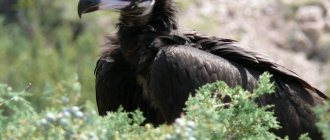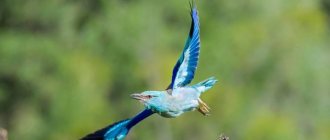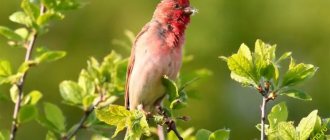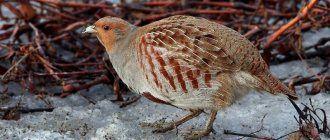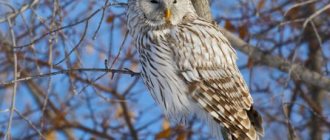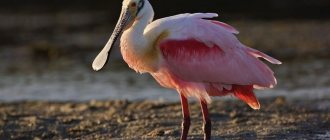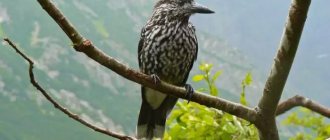The African marabou is the largest member of the stork family. From the name it immediately becomes clear that the bird is indigenous to Africa.
Habitat: central and southern Africa; these birds are not found only in South Africa. Prefers to live in steppes, savannah, river valleys and swampy areas. Does not settle in forests and deserts. Often found in areas of municipal waste dumps near large cities. It can also be found near fish processing sites and slaughterhouses, where there is a large amount of food waste, some of which goes to marabou.
African marabou (lat. Leptoptilos crumeniferus)
Description and features
The bird has long legs and neck; it reaches a height of 1.5 meters. She has strong wings and a massive beak. The wingspan reaches 2.5 meters. The weight of the largest individuals reaches 8 kg. Has excellent vision, which is typical for all types of scavengers.
Their color is two-tone. The lower part of the body is white. The upper part is dark gray. The beak is dirty yellow and reaches 30 cm in length. The neck is orange or red. At a young age, birds have a paler color and depending on the species it can vary.
In addition to the small bare head, a characteristic feature of the bird is in the lower part of the neck, we are talking about a fleshy outgrowth that resembles a bag connected to the nostrils. When inflated, the bag increases to 30 cm in diameter. Previously it was believed that the marabou stored food in this bag, but it was never possible to find confirmation of this theory. Most likely, it is used exclusively for mating games and during rest, the bird lays its head on this outgrowth.
The absence of feathers on the neck and head is associated with diet. Feathers should not become dirty when eating half-rotten food. In addition, marabou is one of the cleanest birds. If a piece of food is dirty, she will eat it only after washing it in water. Unlike their fellow storks, marabou do not extend their necks when flying. They can rise to a height of up to 4 thousand meters.
What does marabou eat?
Photo: Marabou stork
The main source of food for birds is carrion, or waste from landfills near populated areas. The powerful and very long beak is perfectly adapted for separating the flesh of its prey.
Interesting fact: Along with their questionable food culture, marabou are one of the cleanest birds. They will never eat food that is contaminated with anything. Birds will definitely wash it before using it in a pond, and only then eat it.
If there is not enough food among the waste and carrion, they may well hunt various small-sized animals, which they can swallow whole. Birds can hunt by killing prey with a strong, long beak.
What serves as a food base for marabou:
- fish;
- frogs;
- insects;
- reptiles;
- some types of reptiles;
- eggs of other birds.
With the help of such a powerful weapon as a 30-centimeter beak, marabou can easily kill even representatives of flora and fauna with thick skin. With such a beak it is also quite easy to pierce the thick skin of dead animals and separate the flesh from the skeleton.
In search of food, marabou rise high into the sky, where they soar in free flight, looking for suitable prey. Birds tend to gather in large flocks in regions where a large number of large herbivores and ungulates live.
Birds often fish in shallow waters. To catch fish, they simply wade into the water to a shallow depth, lower their open beak into the water and wait motionless. The moment they sense prey, the beak instantly slams shut and the prey is swallowed.
Kinds
The marabou stork is currently represented by three species:
- African;
- Indian;
- Javanese.
Leptoptilos robustus is an extinct species. The bird lived on earth 126-12 thousand years ago. Lived on the island of Flores. The remains of the marabou found indicate that the bird reached 1.8 meters in height and weighed about 16 kg. She probably didn't fly well or didn't do it at all.
Leptoptilos robustus had massive tubular bones and heavy hind limbs, which once again confirms that the bird moved efficiently on the ground and was unlikely to fly. It is believed that such large sizes of the birds are associated with the inability to mix with other populations, because they lived on an isolated island.
In the same cave where the remains of the bird were found, the bones of Flores Man were found. These were short people, with a height of up to 1 meter, that is, they could well act as prey for birds.
African marabou . This is the largest bird of all species, body weight can reach 9 kg, and the wingspan is 3.2 meters, respectively, and the beak is longer, up to 35 cm. Features of the species are that there is rare hair-like plumage on the neck and head. And on the shoulders there is a downy “collar”. The skin on the unfeathered areas is pink, with black spots and horny scutes on the front of the head.
Another characteristic feature is the dark iris on the pupil of the eye. Because of this feature, local residents believe that the bird has a demonic look. This species of stork can live with pelicans, creating mixed colonies. The African species is not in danger of extinction; it is they who settle close to people and garbage dumps.
Indian marabou . It lives in Cambodia and Assam, although previously the habitat was much wider. For the winter it goes to Vietnam, Myanmar and Thailand. Previously, the bird lived in Burma and India, where the name came from. Covering feathers of birds are gray, black below. Another name for the species is argala.
The Indian marabou is listed in the Red Book. According to the latest estimates, there are now no more than 1 thousand individuals of this species. The decline in numbers is due to the draining of swamps and the reduction of suitable habitats due to the constant collection of eggs and the treatment of land with pesticides.
Javan marabou . What continent does it live on ? You can see this marvelous bird in India, China, all the way to the island of Java. Compared to its fellows, this is a small bird, no more than 120 cm in height, with a wingspan of up to 210 cm. The upper part of the wing is covered with black feathers. This species lacks a throat leather pouch.
The Javan stork does not like being close to people and avoids any meetings with humans. It eats mainly fish, crustaceans, small birds and rodents, and locusts. It is a loner and creates a pair only during the breeding season. The number of this species is steadily decreasing, therefore it is classified as a “vulnerable species”.
Lifestyle
Marabou leads a diurnal lifestyle. In the morning the bird goes in search of food. Having taken off above the nest, rising with the help of rising air currents, it soars and glides for a long time, stretching its neck. In this way, the bird tries to detect carrion. Seeing the carcass of an animal, he tears its abdomen and sticks its head inside, removing the entrails.
Several individuals fly up to the carcass, and not only to feast on it, but also to protect the food from uninvited guests. After satiation, the bird's throat sac swells. If birds from a flock hunted separately, then before returning to their habitat, they gather together and go home.
If a marabou hunts a living animal, then having chosen a victim, it kills it with a blow of its beak and swallows it whole. He is not afraid even of large rivals, and easily enters into battle with a hyena and a jackal. In battle, the bird is very aggressive and always emerges victorious. Like all representatives of the stork family, the marabou can stand for a long time in a frozen position on one leg.
Nutrition
The marabou bird feeds on carrion. However, if such food is not available, they do not disdain small animals and birds. A large individual can kill a flamingo or a duck without any problems. A bird needs about 1 kg of food per day. Eats young small animals, lizards and frogs. Eats animal eggs. It may even take prey from smaller predators.
They often eat food together with vultures, despite the fact that they are rivals in the wild. The more perspicacious vulture tears apart the carcass of the prey it finds, and the marabou starts eating after. After lunch together, only the skeleton remains of the carcass. At one time, the stork is able to swallow a piece of meat weighing 600 grams.
The Javan marabou can often be seen with its head lowered into the water, which is how it catches fish. The bird plunges its slightly open beak under the water and as soon as the fish touches the interbeak, the beak immediately slams shut.
Despite the fact that most people have a certain aversion to marabou, she is a real orderly. Even around people, they clean out gutters, collect waste near garbage cans and slaughterhouses. Marabou prevents epidemics in regions with a hot climate, so they cannot harm a person in any way - they only bring benefits.
Where does marabou live?
Photo: African Marabou
This species of birds inhabits the African continent. The main part of the habitat region is located slightly south of the Sahara Desert, as well as in the center and south of the continent. As places to live, it prefers savannahs, steppes, swampy areas, as well as valleys of large rivers. These representatives of storks try to avoid forests and desert regions. They tend to be located in large flocks on the outskirts of large settlements, where there are a large number of landfills with a huge volume of food waste. Birds are absolutely not afraid of people.
On the contrary, they try to get as close as possible to populated areas, since in this case they will be provided with food. The geographical regions inhabited by marabou are quite wide.
Geographical regions of bird habitat:
- Cambodia;
- Assam;
- Thailand;
- Myanmar;
- Sudan;
- Ethiopia;
- Nigeria;
- Mali;
- Cambodia;
- Burma;
- China;
- Java Island;
- India.
These representatives of storks love open areas where the humidity is quite high. They can often be found near meat and fish processing organizations. A prerequisite when choosing a habitat region is the presence of a body of water. If there is a sufficient amount of food in the coastal zone, birds are quite capable of hunting and obtaining their own food. Birds often move to drying up bodies of water where there is a large amount of fish.
If the marabou habitat has favorable conditions and a sufficient food supply, the birds lead a sedentary nesting lifestyle. When the nesting period ends, many birds migrate closer to the equator line and then return back.
Now you know where the marabou stork lives. Let's see what he eats.
Mating games
Unlike most birds, the male chooses the other half. It all starts with several females approaching the male and demonstrating their beauty. The most persistent will get attention. After this, the couple walks around, inflating the bags around their necks, in an attempt to scare away uninvited guests.
Puberty occurs at 4-5 years of age. Mating games begin during the rainy season, and the appearance of chicks occurs during the dry season. The reason for this is simple - it is during the drought that most animals die, so it is much easier to feed the kids.
Only during the mating season does the bird make quiet sounds, because it does not even have vocal cords. The marabou's voice is somewhat reminiscent of a moo, mixed with whistling and howling. With such sounds they scare away birds and animals.
Notes
- Boehme R. L., Flint V. E.
Five-language dictionary of animal names. Birds. Latin, Russian, English, German, French / Under the general editorship of academician. V. E. Sokolova. - M.: Rus. lang., "RUSSO", 1994. - P. 26. - 2030 copies. — ISBN 5-200-00643-0. - Koblik E. A.
Diversity of birds (based on the materials of the exhibition of the Zoological Museum of Moscow State University. - Moscow State University Publishing House, 2001. - Vol. 1 (Class Birds, Orders Ostrichiformes, Tinamoiformes, Penguiniformes, Loons, Grebes, Petrels, Pelicaniformes, Storkiformes, Flamingiformes, Anseriformes, New World Vultures, Falconiformes) - 384 pp. - ISBN 5-211-04072-4. - Large encyclopedia of animals. Life of animals. T. 1 Per. with him. M.: LLC "World of Books", 2002. - 192 p. — ISBN 5-8405-0155-7
- [www.historie.ru/news/16-nahodka-uchenyh-v-peschere-hobbitov.html Scientists’ discovery in the hobbit cave]
Reproduction and lifespan
Families are created in large colonies. Up to 5 pairs can live on one tree. These are mainly baobabs, but they may not settle on such tall trees. The diameter of the nest is on average 1 meter, depth up to 40 cm.
They create nests at a height of 5 meters. “Houses” were spotted even at a height of 40 meters. They can use last year’s “house” or even build a nest on a rock, but very rarely. Both future parents are engaged in construction. The marabou nest is made from leaves and small twigs. One pair has 2-3 eggs. Both parents do the incubation, which takes from 29 to 31 days.
By 95-115 days from birth, chicks are already completely covered with feathers. At 4 months after birth, they begin to learn to fly and can move with their parents to the animal’s carcass. They become completely independent after 12 months. Parents surround their offspring with round-the-clock care and feed them intensively.
Marabou lives on average from 20 to 25 years. In captivity, some individuals live up to 33 years. The birds are in excellent health, despite their specific diet. In nature it has no natural enemies.
Natural enemies of marabou
Photo: Marabou in nature
In natural conditions, birds have practically no enemies. Danger can only threaten chicks who, for some reason, are left alone in the nest unattended. In this case, they can become prey for other large feathered predators, such as eagles. However, this happens extremely rarely, since the marabou has a very developed parental instinct.
In the recent past, humans were considered the main enemy of birds. They destroyed the natural habitat of birds, thus depriving them of a place to live.
In addition, in many African countries, marabou is considered a harbinger of failure, misfortune and illness. People consider him an extremely unpleasant and dangerous representative of flora and fauna. In this connection, they try as much as possible to minimize comfortable conditions for birds to live near human settlements. However, people do not take into account the fact that birds bring great benefits. They clear the space of dead and sick animals. This allows you to avoid the spread of many dangerous infectious diseases. It’s not for nothing that marabou are considered local orderlies of nature.
Interesting Facts
Despite the fact that marabou lives in countries with warm climates, they sometimes settle in places where it is humid, near water bodies. Muslims revere this bird and regard it as a symbol of wisdom. According to one version, it was Muslims who gave the name to the bird and it comes from the word “mrabut”, which means “Muslim theologian”.
Despite this, in African countries to this day the bird is hunted for its beautiful feathers. In some European countries, marabou fluff is used by the police to apply powder to detect fingerprints.
In Nairobi and Kenya, birds often live in villages and towns. The marabou in the photo , surrounded by civil and industrial buildings, looks unique. They build nests in the trees above houses, completely oblivious to the noise and bustle around them. Despite its sanitary function, in most African countries, the bird is considered evil and disgusting.
For its solemn gait on long legs, the marabou is also called the adjutant bird. Another name for the bird is undertaker. According to the observations of workers in the Kruger Park (South Africa), marabou defecates on its feet and, accordingly, they are constantly covered in waste. It is believed that she does this to regulate her own body temperature.
The marabou lived in the Leningrad Zoo for 37 years. He was brought in in 1953, at a young age, he was caught in the wild. Despite its repulsive appearance, marabou is an important link in the ecosystem. Poultry helps reduce the risk of disease in the region where it lives and cleans the environment, which is very important for hot countries.
Behavior
Marabou live in large colonies, inhabiting open savannas, bushland and sea coasts, and also appear in villages in waste dumping areas to find food there. Their diet includes carrion, as well as frogs, insects, young chicks, lizards and rodents. The powerful beak allows you to kill small animals, and the frill protects the rest of the plumage from pus and blood from the corpse.
Marabou can take prey from some predators, such as eagles. Marabou can also eat eggs and baby crocodiles.

